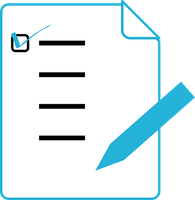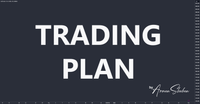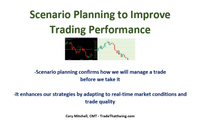Explore web search results related to this domain and discover relevant information.

Creating a trading plan was one of the best decisions I made in my trading. It provided structure, discipline, and a clear path to follow. Here’s how I developed my trading plan and how it…
Creating a trading plan was one of the best decisions I made in my trading. It provided structure, discipline, and a clear path to follow…Here’s how I developed my trading plan and how it transformed my trading practice. ... Goals and objectives. Clear, achievable goals to guide my trading activities. Market analysis. A process for analyzing the markets, including technical and fundamental analysis. Risk management. Rules for managing risk, including position sizing and stop-loss orders. Entry and exit strategies. Criteria for entering and exiting trades.Risk management was a crucial component of my plan. As I once mentioned, I decided never to risk more than 2% of my account on any single trade. I set strict stop-loss orders to protect my capital and reduce emotional stress.I created a checklist for each trade, ensuring I only entered positions that met my standards. This disciplined approach prevented impulsive decisions and improved my trading accuracy. Finally, I established a daily trading routine. Each morning, I analyzed the markets, reviewed my trading plan, and prepared for the day.

A winning Forex trading plan should be the starting point for any journey to becoming a consistently profitable Forex trader. Yet most traders don't...
A winning Forex trading plan should be the starting point for any journey to becoming a consistently profitable Forex trader. Yet unfortunately most traders don’t write one until they’ve blown a few accounts.Even then the task to write a trading plan often falls into the category of, “I’ll get to it when I have time”. So why do most traders avoid taking the time to write one if it’s so important?I attribute this one thing to the phenomena of why so many traders fail – they can’t handle having no rules to follow. Or rather, they didn’t take it upon themselves to set the rules. In this lesson we’re going to take a look at what a Forex trading plan is, why it’s so important as well as some of the topics you should consider including in your trading plan.Every winning Forex trading plan starts with a well-defined trading strategy, or strategies. Every topic below will reflect what you enter here in some way. For me this topic includes the pin bar trading strategy as well as the inside bar trading strategy. It’s important to outline each strategy you will use and outline the market conditions necessary to validate a trade setup.

Walmart CFO John Rainey plans to sell shares in 2026 for financial diversification.
Walmart (NYSE:WMT) CFO John Rainey has entered into a stock trading plan to sell 20K shares on February 2, 2026, and on March 2, 2026 as part of his long-term asset diversification, tax, and financial planning strategy.

A trading plan can help traders and investors to achieve consistent results and avoid emotional or impulsive decisions. A trading plan should be written in a clear and concise manner and be regularly reviewed and updated. One of the main benefits of having a trading plan is that it can help …
What is TRADING PLAN ? A trading plan is a systematic method for identifying and trading securities that takes into consideration a number of variables including time, risk and the investor’s objectives. A trading plan can help traders and investors to achieve consistent results and avoid emotional or impulsive decisions.A trading plan should be written in a clear and concise manner and be regularly reviewed and updated. One of the main benefits of having a trading plan is that it can help traders and investors to define their personal trading style and goals.Other traders may opt for the stocks market, which involves buying and selling shares of well-established and financially sound companies, also known as blue chips. Blue chips are generally considered to be less volatile than forex and may offer steady growth potential and dividends to investors. Another advantage of having a trading plan is that it can help traders and investors to identify the best trading opportunities and strategies for their chosen market and instrument.If I want to explain more, I have to say that Entry and exit rules are the criteria that determine when to open and close a position, based on technical or fundamental analysis, indicators, signals, patterns, trends, etc1. They are essential for having a trading plan and a trading strategy, as they help traders and investors to define their personal trading style and goals, identify the best trading opportunities and strategies, and manage their risk and reward.
A trading plan is a business plan for your trading career. Like any business plan, a trading plan is a working document in which you make assumptions about projected costs, revenues, and business conditions. Some of your assumptions may be right, some will surely be wrong.
Every trader—no matter your experience—needs a plan.You’re in the right place for any those objectives. At the end of this course, you’ll understand why you need a trading plan and how to build one to support your success as a futures trader."He who fails to plan is planning to fail" -Winston Churchill · Traders who win consistently treat trading as a business. While there is no guarantee that you will make money, developing a trading plan is crucial if you want to become consistently successful and thrive in the trading game.A trading plan is a business plan for your trading career. Like any business plan, a trading plan is a working document in which you make assumptions about projected costs, revenues, and business conditions. Some of your assumptions may be right, some will surely be wrong.

MG OMD was incumbent on the account · Reset password: Click here
MG OMD was incumbent on the account.


Scenario Planning takes the guesswork out of trading, improving focus & results. No matter what the market does, you know what YOU will do.
With Scenario Planning you take the guesswork and frustration out of trading, improving your focus and your results. No matter what the market does, you know what YOU have to do. No strategy is going to win all the time or predict what the market will do with certainty. Even if a system is highly accurate in picking in direction, it may have poor timing (be too early or too late), or expose us to too much risk for the profit potential. Many successful traders don’t try to predict the market at all.If you integrate this mental flip, your trading will drastically improve. You no longer need to waste time predicting, and being frustrated when it doesn’t pan out. Rather, you plan the trade, start to finish, no matter what the market does.We can plan for what we will do if the market (or something else) does X, Y, or Z. And we can even have a plan for when we are unsure! Let me give you a non-trade example.It’s a “maybe trade”. A rule like this states you stay out, unless it becomes a “yes”. To become a yes, you’ll need to tell yourself how you’ll manage this trade given that you are uncertain about it, and provide evidence to yourself for why the trade is acceptable to take. It may become a yes, or may stay a Maybe or a No (in either case, you stay out). Life is filled with uncertainty, and so is trading. But that doesn’t mean we never act. We can plan and act in spite of uncertainty.
Find out why you should have a trade plan—and the five elements that may help you put it to work successfully, like objectives and routines.
Professional traders live by maxims, and one of the big ones is "Plan your trade and trade your plan." The market can be volatile, so creating a trade plan can give you a tool for keeping a cool head as you build and reshape positions when markets are on the move.A trade boils down to a series of decisions about what to trade, how much to trade, when to enter, and when to exit. Thinking through those decisions before placing a trade by compiling them into a trade plan can help ensure you enter your orders correctly, can potentially help you manage risk, and can help you establish routines that fit with your trading objectives.A watchlist is a list of securities you're interested in trading because they meet certain criteria. Watchlist criteria can be as broad as picking stocks in a certain industry or sector, but for a trade plan, you'll typically want to try to develop more specific criteria that correlate with your objective.Trading is risky. A good trade plan establishes ground rules for how much you're willing to risk on a single trade. For a general rule, some traders may risk up to 1%–2% of their account on a single trade and allocate up to 5%–10% of their portfolio in any single position.

A trading plan refers to a systematic approach used to identify and trade securities based on several variables, like investment objectives
The underlying elements of a trading plan include the conditions under which to buy and sell securities, the size of the position to be taken, how to manage positions, the types of securities to trade, among others. Investment professionals observe that traders should not risk capital until after a trading plan is developed.With their plan, investors can monitor their performance and evaluate their investment strategies. In the case of amateur traders with no trading plans, they often enter the market ill-equipped with information about profit objectives and risks.Investors with short-term and long-term objectives should establish a tactical trading plan. A trader aims to enter and exit a position at an exact price level or under special requirements in tactical investing.The plan must also set forth how an investor should leave positions, either with a profit or a loss. Tactical traders commonly employ limit orders to leave options with profit, while stop orders are useful when investors want to leave their loss.


Effective risk management and strategic planning are crucial for navigating the challenges of 24-hour trading. The foreign exchange (forex or FX) market is a global marketplace where investors trade currency from different countries. Investors in the forex market trade by predicting which ...
Effective risk management and strategic planning are crucial for navigating the challenges of 24-hour trading. The foreign exchange (forex or FX) market is a global marketplace where investors trade currency from different countries. Investors in the forex market trade by predicting which currencies will increase or decrease in value.Even before technology and regulation expanded after-hours trading, time zones and global market structures make near-24-hour trading a possibility.Because the forex market trades currencies from around the globe, it is open 24/5 for investing opportunities. The trading volume of the forex market makes it the largest market in the world, with daily trading volumes in the trillions in the over-the-counter market (OTC).During this period, commodities and currencies like the yen (JPY), euro (EUR), and the British pound (GBP) frequently experience price volatility as the Euro markets respond to overnight developments in Asia. Fewer economic reports come out during the Tokyo/London overlap. However, this window still has moderate liquidity, and price swings can set up traders for successful trades in London as the day progresses.
Investing and trading can work best with a trading plan. Here's how to make yours.
If you do switch things up, make sure your new plans fit your goals. While most investors are best served investing in a diversified portfolio, contributing regularly, and rebalancing to reach their goals, some investors may have the desire, time, and skill to trade securities.This may seem unintuitive for those familiar with the terms investing and trading, but in this case, "trading" refers simply to the act of buying and selling investments, rather than the amount of time you plan to hold them. That means short-term traders who buy and sell investments for quicker potential profits and long-term investors who plan to hold assets until retirement—as well as everyone in between—may have trading plans.Of course, past performance is no guarantee of future results, but history shows that dips are normal. If you choose to actively trade the market, you have to understand that you may lose some (or even all) of what you trade with. Knowing your willingness and ability to take on risk will help guide how you craft your trading plan.Depending on your financial goals and time horizon, you may be able to benefit from tax-advantaged accounts that help you reach your goals more efficiently. Retirement savings plans, like 401(k)s, 403(b)s, or IRAs, offer specific tax advantages that may lead to higher after-tax returns. Keep in mind though, we do not recommend actively trading retirement assets. And never trade more than you can afford to lose.

Trading without a plan is like driving a car without a steering wheel. You need a plan to follow, a strategy to stick to, and a way to track your progress. Monitoring your progress based on the plan will create a clear vision of what you are doing right and wrong. Before creating a trading […]
Select Portfolios: Choose the portfolio you plan to follow with this Trading Plan. Define Trades to Focus: For example, if the “Gap and Go” setup brings 80% of your profit, specify that you only want to trade this setup.Daily Count: The number of trades taken per day. Setup: The trading strategy or setup used. Mistake: Any errors or deviations from the plan.Trades outside this setup will be tagged as outside the plan.Define Trades to Avoid: For example, if trading on Fridays leads to significant losses, specify in the plan to avoid trading on Fridays.
Follow seven simple steps to creating a successful trading plan. A good trading plan acts as your own personal decision-making tool, helping you decide what, when and how much you should trade.
Learn how to create a successful trading plan and put it into action. With a smart plan, you’ll have guidance on which market to trade, when to take profits, when to cut your losses, and where other opportunities could exist.You need a trading plan because it can help you make logical trading decisions and define the parameters of your ideal trade. A good trading plan will help you to avoid making emotional decisions in the heat of the moment.Figuring out your motivation for trading and the time you’re willing to commit is an important step in creating your trading plan. Ask yourself why you want to become a trader and then write down what you want to achieve from trading.If you want to make a lot of trades a day, you’ll need more time. If you’re going long on assets that will mature over a significant period of time – and plan to use stops, limits and alerts to manage your risk – you may not need many hours a day.

What is a Trading Plan? A trading plan is a comprehensive framework that guides all trading activities, ensuring consistent and disciplined trading practices. It includes your trading goals, strategies, risk management, and evaluation methods. A well-structured trading plan answers the “what, ...
What is a Trading Plan? A trading plan is a comprehensive framework that guides all trading activities, ensuring consistent and disciplined trading practices. It includes your trading goals, strategies, risk management, and evaluation methods. A well-structured trading plan answers the “what, when, how” of your trading activities.First of all – understanding your motivations and setting clear expectations is crucial in developing a trading plan. Making a Living: Are you aiming to trade as your primary source of income?With plenty of time to make her decisions, Monica reviews the market conditions in her free moments and decides her next steps, whether to enter a trade with a market order or set a limit order for execution at a specific price. ____________________________________________________________________________________ Now let’s begin with creating your actual trading plan.Time Horizon: Determine the validity period of this plan and when it will be reviewed. Risk Tolerance: Assess your comfort with potential losses. Considerations: Take into account the ease of risk management, volatility, liquidity, and broker selection. Markets: Decide whether to trade stocks, forex, commodities, cryptocurrencies, etc.
Traders must maintain a disciplined and systematic approach to their trades. A well-defined trading plan helps remove subjectivity and impulse from trading decisions. It incorporates risk management strategies such as setting stop-loss orders and determining position sizes based on risk tolerance.
Determine how you'll manage your open positions. You should determine when to adjust your stop-loss orders, take partial profits, or exit the trade entirely. Stick with your trading plan when you've written it down.Avoid situations where you abandon your trading plan impulsively because the market is doing something that elicits an emotional response from you like fear or greed. Train yourself to embrace discipline and consistency when executing and exiting trades.Traders must maintain a disciplined and systematic approach to their trades. A well-defined trading plan helps remove subjectivity and impulse from trading decisions. It incorporates risk management strategies such as setting stop-loss orders and determining position sizes based on risk tolerance.Practice trading is a useful exercise before you start trading real money in the markets, but it doesn't help a new trader understand how emotion can sway decision-making. That's one reason why a plan is important.
:max_bytes(150000):strip_icc()/GettyImages-1133485268-d58a798a7c6c415d8f32a5e7be41e362.jpg)

How to create a forex trading plan? Learn the top 11 tips for developing a trading plan. Use our customizable template to reach your trading goals.
While you can use someone else’s plan as a guide, it’s crucial to remember that a trading plan should be completely personalized to suit your unique situation. What distinguishes a profitable trader from an unsuccessful one can be as simple as having a well-defined trading plan versus trading without one.You need to specify your trading style in your forex trading plan. The right trading style is crucial for aligning your trading activities with your personal goals, risk tolerance, and lifestyle. There are different types of trading styles, each featuring unique characteristics and strategies, including scalping, day trading, swing trading, and position trading. Scalping is considered a high-frequency trading strategy, consisting of numerous small trades within a single trading day.Another important factor to include in your trading plan when trading forex or other financial markets is the type of market and asset you want to focus on. Identify the type of market you aim to trade, such as forex, stocks, commodities, or cryptocurrencies.The timeframe will influence your trading strategy and risk management techniques. The choice of timeframe should be considered in your trading strategy as well as your trading plan. Traders use different timeframes, such as monthly, weekly, daily, or minutes, based on their trading styles, strategies, and goals.
Start building a long-term trading business plan with our structured framework using this downloadable template. Download · Download your position analysis tool, with built-in calculations for complex options strategies, breakeven points, and profit targets. Download · Successful traders ...
Start building a long-term trading business plan with our structured framework using this downloadable template. Download · Download your position analysis tool, with built-in calculations for complex options strategies, breakeven points, and profit targets. Download · Successful traders typically develop and maintain two distinct but complementary types of trading plans:A simple, short plan created before executing any strategy. Identifies the supporting factors and negatives (risks) for the trade.Get practical techniques to help you trade with more consistency. ... Trading without a written plan is like navigating unfamiliar territory without a map. When volatility strikes or emotions run high, documented strategies provide clear direction and help to prevent costly mistakes.Here’s why putting your plan in writing is crucial: Written rules help prevent impulse trades and enforce discipline.

Un plan de trading es imprescindible para todos los traders exitosos, por lo que decidimos explicártelo todo. ¡Aquí está el tutorial para un plan de trading en Forex con ejemplos!
El trading tiene varios niveles de complejidad. El más fácil implica cosas como la compra y venta de activos aleatorios, y los más integrales incluyen gestión de riesgos deliberada, tiempo y objetivos. Combinados, son imprescindibles para cada trader exitoso.Sin embargo, la falta de un plan de trading suele conducir a pérdidas severas porque el trader tiene dificultad para controlar sus emociones durante una volatilidad extrema en el mercado o después de una serie de ganancias o pérdidas.El plan de trading combina reglas para operar y crea un algoritmo que seguirás. Por lo tanto, el objetivo fundamental del plan es ayudarte a lograr tus objetivos personales en trading. Digamos que tu objetivo №1 es evitar pérdidas importantes. Entonces, tu plan de trading debe contener una parte en la que dejes de operar y tomes un descanso después de una serie de malas operaciones.Un plan de trading es un conjunto de reglas que todo trader debe seguir para lograr sus objetivos.

Watch the markets, follow financial news, and practise on a demo account to understand how trades work in real conditions. Avoid impulsive decisions. Begin with a structured trading plan that outlines your entry and exit points, position sizes, and risk limits.
New traders often feel pressure to act constantly, chasing every market movement. But more trades rarely mean better outcomes. Without a plan, this leads to poor decisions, higher costs, and rapid burnout.Regardless of the strategy, each trade should follow a clear plan:New to day trading? Discover how it works, key strategies, risks, and tips to get started. A beginner-friendly guide to trading smarter.At its core, day trading means buying and selling assets within the same trading day, ensuring no positions are held overnight. The goal is to capitalise on small price fluctuations that occur throughout the day, with trades lasting anywhere from a few minutes to a few hours.
To begin trading, start by understanding the basics. Learn how to create a trading plan, find trade ideas, and explore strategies to take your trading to the next level.
Regardless of how much you trade, sometimes we all need help coming up with smarter trading ideas.You’ve worked hard to get to this point, now it’s time to get ready to place a trade.Key tips on how to place a trade along with an easy step-by-step guide.






:max_bytes(150000):strip_icc()/GettyImages-1133485268-d58a798a7c6c415d8f32a5e7be41e362.jpg)